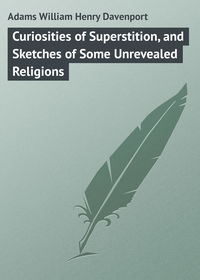 полная версия
полная версияWitch, Warlock, and Magician
The trial of Dame Alicia Kyteler, or Le Poer, takes us across the seas, but it furnishes too many interesting particulars to be entirely ignored. Hutchinson informs us that, in 1324, Bishop de Ledrede, of Ossory, in the course of a visitation of his diocese, came to learn that, in the city of Kilkenny, there had long resided certain persons addicted to various kinds of witchcraft; and that the chief offender among them was a Dame Alicia Kyteler. As she was a woman of considerable wealth, which might prove of great benefit to the Church, the episcopal zeal blazed up strongly, and she and her accomplices were ordered to be put upon their trial.
The accusation against them was divided into seven distinct heads:
First: That, in order to give effect to their sorcery, they were wont altogether to deny the faith of Christ and of the Church for a year or month, according as the object to be attained was greater or less, so that during this longer or shorter period they believed in nothing that the Church believed, and abstained from worshipping Christ’s body, from entering a church, from hearing Mass, and from participating in the Sacrament. Second: That they propitiated the demons with sacrifices of living animals, which they tore limb from limb, and offered, by scattering them in cross-roads, to a certain demon, Robert Artisson (filius Artis), who was ‘one of the poorer class of hell.’ Third: That by their sorceries they sought responses and oracles from demons. Fourth: That they used the ceremonies of the Church in their nocturnal meetings, pronouncing, with lighted candles of wax, sentence of excommunication even against the persons of their own husbands, naming expressly every member, from the sole of the foot to the top of the head, and at length extinguishing the candles with the exclamation, ‘Fi! fi! fi! Amen!’ Fifth: That with the intestines and other inner parts of cocks sacrificed to the demons, with ‘certain horrible worms,’ various herbs, the nails of dead men, the hair, brains, and clothes of children who had died unbaptized, and other things too disgusting to mention, boiled in the skull of a certain robber who had been beheaded, on a fire made of oak-sticks, they had invented powders and ointments, and also candles of fat boiled in the said skull, with certain charms, which things were to be instrumental in exciting love or hatred, and in killing or torturing the bodies of faithful Christians, and for various other unlawful purposes. Sixth: That the sons and daughters of the four husbands of the same Dame Alice had made their complaint to the Bishop, that she, by such sorcery, had procured the death of her husbands, and had so beguiled and infatuated them, that they had given all their property to her and her son [by her first husband, William Outlawe], to the perpetual impoverishment of their own sons and heirs: insomuch that her present [and fourth] husband, Sir John Le Poer, was reduced to a most miserable condition of body by her ointments, powders, and other magical preparations; but, being warned by her maidservant, he had forcibly taken from his wife the keys of her house, in which he found a bag filled with the ‘detestable’ articles above mentioned, which he had sent to the Bishop. Seventh: That there existed an unholy connection between the said Lady Alice and the demon called Robert Artisson, who sometimes appeared to her in the form of a cat, sometimes in that of a black shaggy dog, and at others in the form of a black man, with two tall companions as black as himself, each carrying in his hand a rod of iron. Some of the old chroniclers embroider upon this charge the fanciful details that her offering to the demon was nine red cocks’ and nine peacocks’ eyes, which were paid on a certain stone bridge at a cross-road; that she had a magical ointment,40 which she rubbed upon a coulter or plough handle, in order that the said coulter might carry her and her companions whithersoever they wished to go; that in her house was found a consecrated wafer, with the devil’s name written upon it; and that, sweeping the streets of Kilkenny between complin and twilight, she raked up all the ordure towards the doors of her son, William Outlawe, saying to herself:
‘To the house of William my son,Hie all the wealth of Kilkenny town.’The lady, rejoicing in powerful friends and advisers, defied the Bishop and all his works. She was excommunicated, and her son summoned to appear before the Bishop for the offence of harbouring and concealing her; but Dame Alice’s friends retaliated by throwing the Bishop into prison for several days. He revenged himself by placing the whole diocese under an interdict, and again summoning William Outlawe to appear on a certain day; but before the day arrived, he in his turn was cited before the Lord Justice, to answer for having imposed an interdict on his diocese, and to defend himself against accusations submitted by the seneschal. The Bishop pleaded that it was unsafe for him to travel; but the plea was not allowed, and, to save himself from further molestation, he recalled the interdict.
The quarrel was not yet fought out. On the Monday following the octave of Easter, the seneschal, Arnold de la Poer, held his judicial court in the Assize Hall at Kilkenny. Thither repaired the Bishop, and, though refused admission, he forced his way in, robed in full pontificals, carrying in his hand the Host in pyx of gold, and attended by a numerous train of friars and clergy. But he was received with a storm of insults and reproaches, which compelled him to retire. Upon his repeated protests, however, and at the intercession of some influential personages, his return was permitted. Being ordered to take his stand at the criminal’s bar, he exclaimed that Christ had never been treated so before, since He stood at the bar before Pontius Pilate; and he loudly called upon the seneschal to order the arrest of the persons accused of sorcery, and their deliverance into his hands. When the seneschal abruptly refused, he opened the book of the decretals, and saith, ‘You, Sir Arnold, are a knight, and instructed in letters, and that you may not have the excuse of ignorance, we are prepared to prove by these decretals that you and your officials are bound to obey our order in this matter, under heavy penalties.’
‘Go to the church with your decretals,’ replied the seneschal, ‘and preach there, for none of us here will listen to you.’
In the Bishop’s character there must have been a fine strain of perseverance, for all these rebuffs failed to baffle him, and he actually succeeded, after a succession of disappointments and a constant renewal of difficulties, in obtaining permission to bring the alleged offenders to trial. Most of them suffered imprisonment; but Dame Alice escaped him, being secretly conveyed to England. Of all concerned in the affair, only one was punished: Petronella of Meath, who was selected as a scapegoat, probably because she had neither friends nor means of defence.
By order of the Bishop she was six times flogged, after which the poor tortured victim made a confession, in which she declared not only her own guilt, but that of everybody against whom the Bishop had proceeded. She affirmed that in all Britain, nay, indeed, in the whole world, was no one more skilled in magical practices than Dame Alice Kyteler. She was brought to admit the truth – though in her heart she must have known its absolute falsehood41– of the episcopal indictment, and pretended that she had been present at the sacrifices to the Evil One – that she had assisted in making the unguents with the unsavoury materials already mentioned, and that with these unguents different effects were produced upon different persons – the faces of certain ladies, for instance, being made to appear horned like goats; that she had been present at the nocturnal revelries, and, with her mistress’s assistance, had frequently pronounced sentence of excommunication against her own husband, with all due magical rites; that she had attended Dame Alice in her assignations with the demon, Robert Artisson, and had seen acts of an immorality so foul that I dare not allude to it pass between them. Having been coerced and tortured into this amazingly wild and fictitious confession, the poor woman was declared guilty, sentenced, and burned alive, the first victim of the witchcraft delusion in Ireland.
It is worthy of observation that the mind of the public was roused to a much stronger feeling of hostility against witchcraft than against magic. Alchemists, astrologers, fortune-tellers, diviners, and the like, might incur suspicion, and sometimes punishment; but, on the whole, they were treated with tolerance, and even with distinction. For this inequality of treatment two or three reasons suggest themselves. In the crime of witchcraft the central feature was the compact with the demon, and it was natural that men should resent an act which entailed the eternal loss of the soul. Again, witchcraft, much more frequently than magic, was the instrument of personal ill-feeling, and was more generally directed against the lower classes. The magician seldom used his power except when liberally paid by an employer; the witch, it was thought, exercised her skill for the gratification of her own malice. However this may be, an imputation of witchcraft became, in the fifteenth century, a formidable affair, ensuring the death or ruin of the unfortunate individual against whom it was made. There was no little difficulty in defending one’s self; and in truth, once made, it clung to its victim like a Nessus’s shirt, and with a result as deadly.
Its value as a political ‘move’ was shown in the persecution of the Knights Templars, and, in our own history, in Cardinal Beaufort’s intrigue against Humphrey, Duke of Gloucester, who governed England as Protector during the minority of Henry VI.
The Cardinal struck at the Duke through his beautiful wife, Eleanor Cobham. In July, 1441, two ecclesiastics, Roger Bolingbroke, and Thomas Southwell, a canon of St. Stephen’s Chapel, were arrested on a charge of high treason; ‘for it was said that the said Master Roger should labour to consume the King’s person by way of necromancy; and that the said Master Thomas should say masses upon certain instruments with the which the said Master Roger should use his said craft of necromancy.’ Bolingbroke was a scholar, an adept in natural science, and an ardent student of astronomy: William of Worcester describes him as one of the most famous clerks of the world. One Sunday, after having undergone rigorous examination, he was conveyed to St. Paul’s Cross, where he was mounted ‘on a high stage above all men’s heads in Paul’s Churchyard, whiles the sermon endured, holding a sword in his right hand and a sceptre in his left, arrayed in a marvellous array, wherein he was wont to sit when he wrought his necromancy.’
The Duchess of Gloucester, meanwhile, perceiving that her ruin was intended, fled to sanctuary at Westminster. Before the King’s Council Bolingbroke was brought to confess that he had plied his magical trade at the Duchess’s instigation, ‘to know what should fall of her, and to what estate she should come.’ In other words, he had cast her horoscope, a proceeding common enough in those days, and one which had no treasonable complexion. The Cardinal’s party, however, seized upon Bolingbroke’s confession, and made such use of it that the unfortunate lady was cited to appear before an ecclesiastical tribunal composed of Chicheley, Archbishop of Canterbury, Cardinal Beaufort, Bishop of Winchester, Cardinal Kemp, Archbishop of York, and Ayscough, Bishop of Salisbury, on July 2, ‘to answer to divers articles of necromancy, of witchcraft or sorcery, of heresy, and of treason.’ Bolingbroke was brought forward as a witness, and repeated that the Duchess ‘first stirred him to labour in his necromancy.’
After this, he and Southwell were indicted as principals of treason, and the Duchess as accessory, though, if his story were true, their positions should have been reversed. At the same time, a woman named Margery Goodman, and known as the ‘Witch of Eye,’ was burned at Smithfield because in former days she had given potions and philtres to Eleanor Cobham, to enable her to secure the Duke of Gloucester’s affections. Roger Bolingbroke was hung, drawn, and quartered, according to the barbarous custom of the age; Southwell escaped a similar fate by dying in the Tower before the day appointed for his trial. The charge of high treason brought against them rested entirely on the allegation that, at the Duchess’s request, they had made a waxen image to resemble the King, and had placed it before a fire, that, as it gradually melted, so might the King gradually languish away and die. As for the Duchess, she was sentenced to do penance, which she fulfilled ‘right meekly, so that the more part of the people had her in great compassion,’ on Monday, November 13, 1441, walking barefoot, with a lighted taper in her hand, from Temple Bar to St. Paul’s, where she offered the taper at the high altar. She repeated the penance on the Wednesday and Friday following, walking to St. Paul’s by different routes, and on each occasion was accompanied by the Lord Mayor, the sheriffs, and the various guilds, and by a multitude of people, whom the repute of her beauty and her sorrows had attracted, so that what was intended for a humiliation became really a triumph. She was afterwards imprisoned in Chester Castle, and thence transferred to the Isle of Man.
The charge of sorcery which Richard III. brought against Lord Hastings, accusing him of having wasted his left arm, though from his birth it had been fleshless, dry, and withered, is made the basis of an effective scene in Shakespeare’s ‘Richard III.’ His brother’s widow, Queen Elizabeth Woodville, was included in the charge, and Jane Shore was named as her accomplice. This frail beauty was brought before the Council, and accused of having ‘endeavoured the ruin and destruction of the Protector in several ways,’ and particularly ‘by witchcraft had decayed his body, and with the Lord Hastings had contrived to assassinate him.’ The indictment, however, was not sustained, and her offence was reduced to that of lewd living. Whereupon she was handed over to the Bishop of London to do public penance for her sin on Sunday morning in St. Paul’s Cathedral church. Clothed in a white sheet, with a wax taper in her hand, and a cross borne before her, she was led in procession from the episcopal palace to the cathedral, where she made open confession of her fault. The moral effect of this exhibition seems to have been considerably marred by the beauty of the penitent, which produced upon the multitude an impression similar to that which the bared bosom of Phryne produced upon her judges in the days of old.
In 1480 Pope Innocent VIII. issued a Bull enjoining the detection, trial, and punishment (by burning) of witches. This was the first formal recognition of witchcraft by the head of the Church. In England the first Act of Parliament levelled at it was passed in 1541. Ten years later two more statutes were enacted, one relating to false prophecies, and the other to conjuration, witchcraft and sorcery. But in no one of these was witchcraft condemned qua witchcraft; they were directed against those who, by means of spells, incantations, or compacts with the devil, threatened the lives and properties of their neighbours. When, in 1561, Sir Edward Waldegrave, one of Mary Stuart’s councillors, was arrested by order of Secretary Cecil as ‘a mass-monger,’ the Bishop of London, to whom he was remitted, felt no disposition to inflict a heavy penalty for hearing or saying of mass; but, on inquiry, he discovered that the officiating priest had been concerned in concocting ‘a love-philtre,’ and he then decided that sorcery would afford a safer ground for process. He applied, therefore, to Chief Justice Catlin, to learn what might be the law in such cases, and was astonished when he was told that no legal provision had been made for them. Previously they came before the Church Courts; but these had been deprived of their powers by the Reformation, and the only precedent he could find for moving in the matter belonged to the reign of Edward III., and was thus entered on the roll:
‘Ung homme fut prinse en Southwark avec ung teste et ung visaige dung homme morte avec ung lyvre de sorcerie en son male et fut amesné en banke du Roy devant Knyvet Justice, mais nulle indictment fut vers lui, por qui les clerkes luy fierement jurement que jamais ne feroit sorcerie en après, et fut delyvon del prison, et le teste et les lyvres furent arses a Totehyll a les costages du prisonnier.’ (That is: A man was taken in Southwark, with a dead man’s skull and a book of sorcery in his wallet, and was brought up at the King’s Bench before Knyvet Justice; but no indictment was laid against him, for that the clerks made him swear he would meddle no more with sorcery, and the head and the books were burnt at Tothill Fields at the prisoner’s charge.)
But in the following year Parliament passed an Act which defined witchcraft as a capital crime, whether it was or was not exerted to the injury of the lives, limbs, and possessions of the lieges. Thenceforward the persecution of witches took its place among English institutions. During the latter years of Elizabeth’s reign several instances occurred. Thus, on July 25, 1589, three witches were burnt at Chelmsford. The popular mind was gradually familiarized with the idea of witchcraft, and led to concentrate its attention on the individual marks, or characteristics, which were supposed to indicate its professors. Even among the higher classes a belief in its existence became very general, and it is startling to find a man like the learned and pious Bishop Jewell, in a sermon before Queen Elizabeth, saying: ‘It may please your Grace to understand that witches and sorcerers within these last four years are marvellously increased within this your Grace’s realm. Your Grace’s subjects pine away even unto the death; their colour fadeth; their flesh rotteth; their speech is benumbed; their senses are bereft! I pray God they may never practise further than upon the subject!’ (1598).
The witches in ‘Macbeth’ – those weird sisters who met at midnight upon the blasted heath, and in their caldron brewed so deadly a ‘hell-broth’ – partake of the dignity of the poet’s genius, and belong to the vast ideal world of his imagination. No such midnight hags crossed the paths of ordinary mortals. The Elizabethan witch, who scared her neighbours in town and village, and flourished on their combined ignorance and superstition, appears, however, in ‘The Merry Wives of Windsor,’ where Master Ford describes ‘the fat woman of Brentford’ as ‘a witch, a quean, an old cozening quean!’ He adds: ‘Have I not forbid her my house? She comes of errands, does she? We are simple men; we do not know what’s brought to pass under the profession of fortune-telling. She works by charms, by spells, by the figure; and such daubery as this is beyond our element.’ Most of Master Ford’s contemporaries, I fear, were, in this matter, ‘simple men.’ Even persons of rank and learning, of position and refinement, were as credulous as their poorer, more ignorant, and more vulgar neighbours; were just as ready to believe that an untaught village crone had made a compact with the devil, and bartered her soul for the right of straddling across a broom or changing herself into a black cat!
Near Warboise, in Huntingdonshire, in 1593, lived two gentlemen of good estate – Mr. Throgmorton and Sir Samuel Cromwell. The former had five daughters, of whom the eldest, Joan, was possessed with a lively imagination, which busied itself constantly with ghosts and witches. On one occasion, when she passed the cottage of an old and infirm woman, known as Mother Samuel, the good dame, with a black cap on her head, was sitting at her door knitting. Mistress Joan exclaimed that she was a witch, hurried home, went into convulsions, and declared that Mother Samuel had bewitched her. In due course, her sisters followed her example, and they too laid the blame of their fits on Mother Samuel. The parents, not less infatuated than the children, lent ready ears to their wild tales, and carried them to Lady Cromwell, who, as a friend of Mrs. Throgmorton, took the matter up right earnestly, and resolved that the supposed witch should be put to the ordeal. Sir Samuel was by no means unwilling; and the children, encouraged by this prompt credulity, let loose their fertile inventions. They declared that Mother Samuel sent a legion of evil spirits to torment them incessantly. Strange to say, these spirits had made known their names, which, though grotesque, had nothing of a demoniac character about them – ‘First Smack,’ ‘Second Smack,’ ‘Third Smack,’ ‘Blue,’ ‘Catch,’ ‘Hardname,’ and ‘Pluck’ – names invented, of course, by the young people themselves.
At length the aggrieved Throgmorton, summoning all his courage, repaired to Mother Samuel’s humble residence, seized upon the unhappy old crone, and dragged her into his own grounds, where Lady Cromwell and Mrs. Throgmorton and her children thrust long pins into her body to see if they could draw blood. With unmeasured violence, Lady Cromwell tore the old woman’s cap from her head, and plucked out a handful of her gray hair, which she gave to Mrs. Throgmorton to burn, as a charm that would protect her from all further evil practices. Smarting under these injuries, the poor old woman, in a moment of passion, invoked a curse upon her torturers – a curse afterwards remembered against her, though at the time she was allowed to depart. For more than a year her life was made miserable by the incessant persecution inflicted upon her by the two hostile families, who, on their part, declared that her demons brought upon them all kinds of physical ills, prevented their ewes and cows from bearing, and turned the milk sour in the dairy-pans. It so happened that Lady Cromwell was seized with a sudden illness, of which she died, and though some fifteen months had elapsed since the utterance of the curse, on poor Mother Samuel was placed the responsibility. Sir Samuel Cromwell, therefore, felt called upon to punish her for her ill-doing.
By this time the old woman, partly through listening to the incessant repetition of the charges against her, and partly, perhaps, from a weak delight in the notoriety she had attained, had come to believe, or to think she believed, that she was really the witch everybody declared her to be – just as a young versifier is sometimes deluded into a conviction of his poetic genius through unwisely crediting the eulogies of an admiring circle of friends and relatives. On one occasion, she was forcibly conveyed into Mrs. Throgmorton’s house when Joan was in one of her frequently-recurring fits, and ordered to exorcise the demon that was troubling the maid, with the formula: ‘As I am a witch, and the causer of Lady Cromwell’s death, I charge thee, fiend, to come out of her!’ The poor creature did as she was told, and confessed, besides, that her husband and her daughter were her associates in witchcraft, and that all three had sold their souls to the devil. On this confession the whole family were arrested, and sent to Huntingdon Gaol. Soon afterwards they were tried before Mr. Justice Fenner, and put to the torture.
In her agony the old woman confessed anything that was required of her – she was a witch, she had bewitched the Throgmortons, she had caused the death of Lady Cromwell. Her husband and her daughter, stronger-minded, resolutely asserted their innocence. Ignorance, however, would not be denied its victims; all three were sentenced to be hanged, and to have their bodies burned. The daughter, who was young and comely, was regarded compassionately by many persons, and advised to gain at least a respite by pleading pregnancy. She indignantly refused to sacrifice her good name. They might falsely call her a witch, she exclaimed, but they should not be able to say that she had acknowledged herself to be a harlot. Her old mother, however, caught at the idea, and openly asserted that she was with child, the court breaking out into loud laughter, in which she fatuously joined. The three victims suffered on April 7, 1595.
Out of the confiscated property of the Samuels, Sir Samuel Cromwell, as lord of the manor, received a sum of £40, which he converted into an annual rent-charge of 40s. for the endowment of an annual sermon or lecture on the iniquity of witchcraft, to be delivered by a D.D. or B.D. of Queen’s College, Cambridge. This strange memorial of a shameful and ignorant superstition was discontinued early in the eighteenth century.





